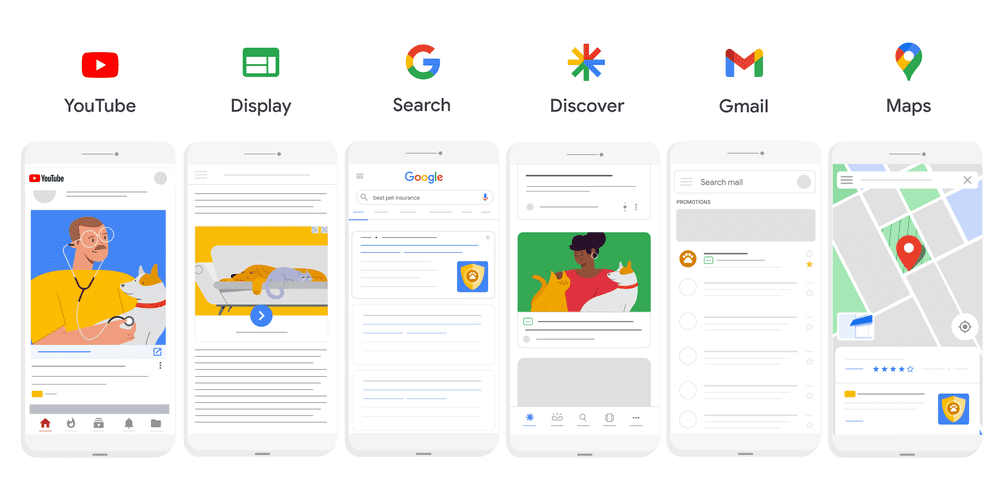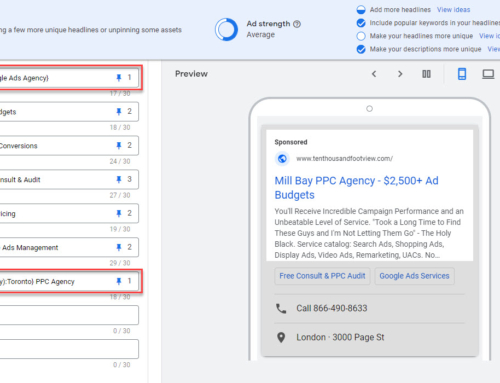Google’s new Performance-Max (P-Max) campaign type has been seeing amazing adoption over the past few months. With most advertisers experiencing excellent performance numbers, it’s no wonder that P-Max spending is going up and search spending is going down. But this introduces a number of problems for advertisers and the entire industry built around Google Ads.
In this article I’m going to explore the many ways this is great news for Google and bad news for everybody that’s not Google. In that group, I include advertisers, agencies, MarTech companies, and competing ad platforms.
What are Performance-Max campaigns?
P-Max is a relatively new “smart” campaign type that runs across all of Google’s inventory including Search, Shopping, Google’s Display Network (GDN), Discovery, YouTube, and Maps. Largely automated, advertisers provide responsive creative assets, multiple audience segments that “signal” targeting, and an optional product feed for shopping, local inventory, and dynamic remarketing.
Importantly, Google chooses where, when, and to whom it runs ads. Advertisers have virtually no control over or granular reporting to make sense of what’s driving conversions.
When are P-Max campaigns useful?
First, Performance-Max campaigns are a replacement for Smart Shopping. If you were recently running Smart Shopping campaigns, those will have already been converted to P-Max in most markets. This is a mandatory change.
Second, P-Max campaigns are great when run in conjunction with paid search. Using account-level data, P-Max will find additional conversions from currently untargeted keywords and further up the funnel on their various display/video networks. Besides generating incremental conversions, the display ads also help fill the top of the funnel, further boosting your search channel performance.
In this regard, they are a great option to replace multiple campaigns that advertisers would typically run for brand awareness and to influence decision-making. This simplifies management and usually leads to better overall performance.
One important point about P-Max is that other than dynamic remarketing when running shopping ads, it is not a general remarketing solution.
4 Ways P-Max campaigns are great for Google
Here are 4 obvious ways that Performance-Max campaigns are an absolute boon for Google.
Google can sell more display/video inventory
By taking control away from advertisers, Google can run ads wherever they want. This includes often-unwanted display placements such as mobile ads and low-quality video channels/partners. While advertisers can block display placements at the account level, Google provides little in the way of placement details other than ad impressions. This means advertisers have no practical way to identify and block poor-quality placements other than subjectively. That process involves visiting one placement at a time and deciding whether it’s relevant and/or potentially click fraud.
Google can sell more search inventory
As with Smart Shopping, P-Max doesn’t allow advertisers to choose which keywords to target or which queries to block for shopping ads. Google has upped their game here, also preventing any control over keyword targeting for the integrated dynamic search ads. At the same time, Google doesn’t provide any search query reporting at all.
While some Google reps will add negative keyword lists for advertisers, they never volunteer the service and some outright refuse to do so. And, since advertisers have no search terms reports, how would they know what to block in the first place?
This gives Google full dominion over what queries to run search ads for.
Google can claim a big win for user privacy
Because advertisers get virtually no detailed reporting from P-Max, Google can say that they are protecting user privacy. This looks good to consumers which will boost trust with Google’s user base.
Google can reduce customer support costs
Google’s end game here is to eliminate a bunch of campaign types and hide what’s going on behind the curtain. This “what advertisers don’t know can’t hurt them” approach means far fewer questions and complaints from those folks. At the same time, P-Max campaigns require less tinkering on an ongoing basis, so it’s unlikely that advertisers will break something by accident.
5 Ways P-Max campaigns are bad for everybody else
Here are 5 ways that P-Max campaigns are going to hurt advertisers, agencies, and others.
Branded search is mandatory
As I mentioned above, Performance-Max will run any/all keywords that aren’t currently running in dedicated search campaigns. That means if you’re not currently running ads for your brand, those queries will be targeted by P-Max. Herein lies a number of problems for advertisers.
First, many advertisers simply don’t want to invest in branded search. It should be within their control to prevent this from happening, but it’s not. Second, branded search is low-hanging fruit, with advertisers typically seeing conversion rates 10x compared to non-branded keywords. That means that overall P-Max numbers are going to be severely skewed and look great. Without query data, advertisers have no idea whether all of the P-Max conversions are coming from branded while the rest of P-Max spend is a total waste.
Some Google reps may help advertisers block branded keywords, but many don’t, and a lot of advertisers don’t even have a rep. Google might provide a way to add account-level negatives in the future, but until then this is really bad.
I strongly urge all P-Max advertisers to build out a separate branded search campaign so they can more accurately assess P-Max performance.
Click fraud is rampant and unstoppable
We’ve had to shut down P-Max for a few clients already due to unstoppable click fraud. Google may be catching and/or crediting most of the fraudulent clicks, but it sure doesn’t seem like it. Also, this doesn’t prevent advertisers from getting hammered by fake leads which causes all kinds of sales SNAFUS and overreporting of conversions.
In the past, we could review and block bad placements and even run scripts to deal with them. We could also block IPs either manually or with the help of a 3rd party click fraud protection service. P-Max, of course, only provides summary impression reports for placements and doesn’t offer an interface for IP blocking.
This hurts advertisers, makes their agencies look bad, and may well put the click fraud protection industry out of business.
This is a serious problem that Google needs to address to avoid backlash… we’ll see how this plays out as P-Max adoption continues to explode.
Optimization opportunities are very limited
Since each asset set contains a single responsive creative unit and combination audience there are few insights advertisers can draw from the results. As such, we can really only swap out low-performing ad components with new ones based on impression volume and Google’s scoring system. Comparing that with RSAs, where we can run multiple ads, pin ad copy, and run ad variations, P-Max ads are subpar at best.
As for audiences, we cannot get any specific insights or adjust bidding for specific segments. We can, of course, add more segments based on campaign signals, but those are few and far between.
Likewise, there are no search term reports so there are no keywords to add or block.
This isn’t great for PPC agencies that make their living off of analyzing results and implementing changes. It’s similarly bad for PPC automation software companies since they can’t add any value.
The lack of campaign insights means you cannot utilize that information elsewhere
Over the years marketing has gone from a linear funnel to an integrated flywheel approach. Marketing channels no longer work in isolation, yet that’s what Google is imposing with Performance-Max. Whereas we would typically learn from audiences, keywords, and creatives and apply those insights to other channels, that’s simply not possible here.
Even Google themselves have been bullish on using value-based bidding and offline conversions to improve campaign profitability. To that end, Google has provided the “value rules” interface in Performance-Max campaigns, but where are we supposed to get the audience insights from to implement this?
Performance-Max campaigns tend to leach search queries from search campaigns
Over time advertisers will likely notice that P-Max campaigns become more hungry for budget while spending declines on search campaigns. As a reminder, P-Max campaigns can and will target any queries that do not directly match an existing search campaign keyword. And since Google pushes advertisers to run fewer and broader keywords in search campaigns, you’re likely not protecting much of your search inventory.
If you keep raising your P-Max budget you are going to continue seeing your search campaigns dry up. This means you’ll have even less control and fewer data to work with in the long run.
Summary
There is no doubt that Performance-Max campaigns are turning in great conversion performance for most advertisers. But the black box approach makes it nearly impossible to understand whether those conversions are coming from branded keywords, queries that already convert in existing search campaigns, targeted display/video, remarketing ads, or somewhere else.
This makes it difficult to know whether P-Max is doing much other than converting on low-hanging fruit while also carelessly spending on low-quality clicks elsewhere. It’s exactly for this reason that most advertisers break out branded and remarketing into separate campaigns. This allows us to understand whether other campaigns such as targeted display and video are driving conversions.
As such, Google can easily pitch P-Max as a simple high-performing catch-all solution for small businesses.
In the meantime, we’re getting less data, quite possibly lower overall performance, and a complete loss of control over our ads.







What is this P-Max placement report? Does it show where the ad appeared?
i’ve had this exact same problem with P Max – fake leads coming through. Real users but fake leads though, as in the users never having filled the form yet the forms had their details!
Does P Max suffer more from click fraud though?
I think you missed one way how P Max will be a big headache for Google in the near future: competition.
The EU has hauled Google to court multiple times and P Max is going to lead Google there again in my opinion.
This is because of the bidding system in P Max. Advertisers are forced to use Google’s own smart bidding strategy.
So Google gets to set the bids for everyone on their own platform. And Google gets paid per click. What do you think will happen to the cpc?
It’s the fox in the henhouse and no choice about that.
P Max is a ticking time bomb that will explode in Google’s face.
The placement report is available from Google reports. It shows impressions for what placements the ads showed on, i.e. publisher sites. P-Max doesn’t necessarily suffer from more click fraud than other campaigns that contain display ads, but they are harder to deal with because you cannot view all the KPIs associated with placements nor can 3rd party tools block IPs through P-Max.
Privacy is an ongoing issue in all markets but particularly in the EU. It’s possible Google will need to add more transparency to P-Max campaigns or not offer them some places.
I am not saying you are wrong, but I am curious on how you detect click fraud and gauge it to be rampant when there is so little information available to us. I’d love to learn how to identify it in our PMAX.
Fake leads coming through your web forms as conversions is a great indicator of this. You may also see a lot of bot traffic tracked through Google Analytics. You can also check your P-Max placements reports and manually review any placements that are seeing a high volume of impressions but don’t appear to be relevant to what you offer.